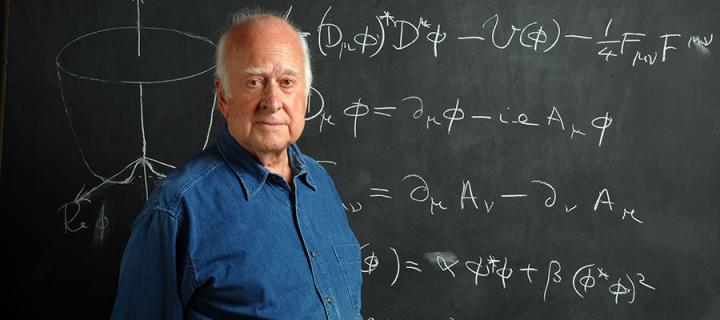Peter Ware Higgs
Nobel Prize physicist, Emeritus Professor of Theoretical Physics.

Background
Peter Higgs was born on 29 May 1929 in Newcastle upon Tyne, and spent his childhood in Birmingham and Bristol.
He studied at King’s College, University of London, and graduated in 1950 with a first class honours in Physics. A year later, he was awarded an MSc and started his research, initially under the supervision of Charles Coulson and, subsequently, Christopher Longuet-Higgins.
In 1954, he was awarded a PhD for a thesis entitled 'Some Problems in the Theory of Molecular Vibrations', work which signalled the start of his life-long interest in the application of the ideas of symmetry to physical systems.
Career
In 1954, Higgs moved to the University of Edinburgh for his second year as a Royal Commission for the Exhibition of 1851 Senior Student, and remained for a further year as a Senior Research Fellow.
He returned to London in 1956 and worked at both University College and Imperial College, before returning to Edinburgh in 1960, where he took up a lectureship in Mathematical Physics at the Tait Institute.
He was promoted to Reader in 1970, became a Fellow of the Royal Society of Edinburgh in 1974, was promoted to a Personal Chair of Theoretical Physics in 1980 and was elected Fellow of the Royal Society in 1983 and Fellow of the Institute of Physics in 1991.
His contribution to physics has been recognised by numerous academic honours.
Higgs retired in 1996, becoming Professor Emeritus at the University of Edinburgh.
Higgs' research
Professor Higgs was a researcher at the University in 1964 when he predicted a sub-atomic particle, now known as the Higgs boson, which enables other particles to acquire mass.
His idea was borne out by experiments almost 50 years later, in 2012, at the European Organization for Nuclear Research (CERN) in Switzerland.
Nobel Prize
Higgs was awarded the 2013 Nobel Prize in Physics, jointly with François Englert, for "the theoretical discovery of a mechanism that contributes to our understanding of the origin of mass of subatomic particles, and which recently was confirmed through the discovery of the predicted fundamental particle, by the ATLAS and CMS experiments at CERN's Large Hadron Collider".
The Prize was awarded jointly because both physicists proposed similar theories independently of one another in 1964.
The Nobel Prize in Physics 2013
The plaque
Higgs' plaque can be found at Roxburgh Street in Edinburgh.
The installation marks the site where Nobel Laureate Professor Higgs first devised his seminal theory on the nature of mass.
The plaque is sponsored by the Institute of Physics and Edinburgh City Council.
Institute of Physics
Peter Ware Higgs
Born 1929
Theoretical physicist and Nobel Laureate in Physics 2013, wrote the papers that predicted the Higgs boson in this building in 1964

